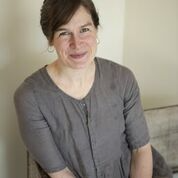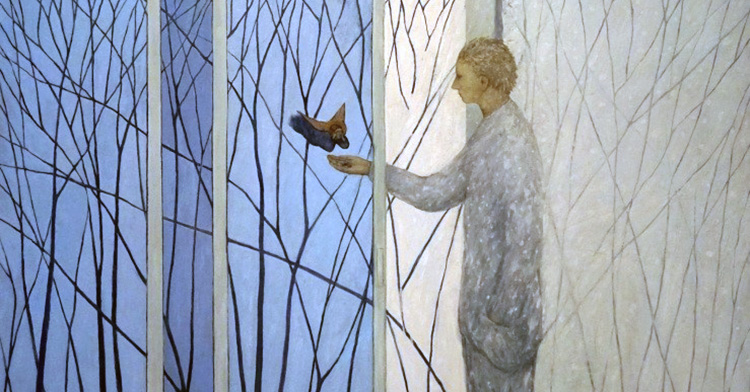On a hot Monday in early July, I hacked branches off 30-foot bamboo stalks with a machete. A congregant cut down more bamboo with a saw, and two others clipped off small twigs. Another dragged the clean stalks out of the bamboo stand.
This wasn’t a mission trip or a weekend garden project; this Monday-on-the-clock was the start of one of my most powerful weeks of ministering to the community.
As the machete worked blisters into my hands, I faced the question that shadows so many pastors who are experimenting with creative forms of ministry: Does this count? What on earth am I getting away with? Is this really ministry?
The bamboo project started with a letter. First Church, my small New England congregation, is nestled among sister towns that host Art Grows Here, an annual 10-day outdoor, map-guided arts tour. The letter, from the organizers, was inviting our church to create an installation of our own or to host another artist’s installation.
The latter, honestly, would have been so much easier! But I had heard of Art Grows Here, and had been stunned at the number of visitors who would turn out for it. The project offered an opportunity for connection, for creating art on a very local level, for innovation, engagement and witness. I wanted First Church to be a part of it.
Our sister towns tend to be sleepy. Usually, residents head elsewhere for action: commuter rail takes most working residents into Boston, and we drive out of town for everything from groceries to gasoline. We don’t have farmers markets, beaches and hip downtown coffee shops, like some places nearby.
But I knew that if we could bring people into town, our congregation was in a great position to attract them: First Church sits directly across from the town hall and the local history museum. It has a classic New England appearance but is welcoming to folks who have struggled in traditional church settings. Could a public art project interest visitors in our church?
Our building is undergoing renovation and has little usable meeting space for now outside our iconic sanctuary. But it occurred to me that we could create an outside gathering space, with seating and a table for cold drinks.
I wanted to make it out of natural materials, designed to let the breeze blow through and take full advantage of our lawn’s leafy shade. It could be a space that would welcome the congregation and also the community.
But two weeks out, the project seemed like a disaster: I had almost no volunteer support, no materials and only a vague plan. As my summer-loving congregation seemed to fade into vacations, I felt like I was dragging the idea along.
I had given up making announcements in church, tired of the congregants’ wide-eyed silence. My requests for twigs and branches seemed to confuse them.
But that Sunday, congregants started approaching me, offering to help. Someone suggested that we use branches from a recent tree trimming; another suggested a neighbor’s bamboo. We chose the bamboo because it was lightweight and abundant; the neighbor knew it would grow back quickly where we were clearing out last year’s stalks.
I had imagined that this would be a lonely project -- I’d felt that way as I’d rubbed my temples in my office, scheming and recruiting over email.
But once we got outside, children on bicycles and neighbors in cars pulled over to see what we were up to.
We loaded the bamboo on top of a pickup truck and delivered it to the front lawn of the church. We built the structure around a central oak tree, with a frame that we lashed high up the trunk and staked to the ground.
A crew of middle schoolers and parents arranged the bamboo by height and wove the rods together into mats. We then tied the mats to the frame, creating a semicircular screen around the tree, the bamboo’s slender tips pointed skyward.
We rolled in old tree stumps for seating. A congregant put her camp-counselor skills to use and fashioned a table of cut branches around the trunk, forming the centerpiece of the installation.
The community’s curiosity grew throughout the week. People stopped to ask questions, or simply watched long enough that they were easily drawn into conversation. The town held a summer camp at a playground two doors down from the church, so pickup and drop-off times brought families chatting along on bicycles, mothers asking questions out of car windows and children looking curiously into the branches.
Suddenly, my new “office” -- outdoors in this public space, a hub of odd activity -- became the best place I could be. I saw parents and kids who don’t come to worship all summer. Congregants drove by asking to help, asking what was happening, asking for an update.
I met parents, kids and grandparents who had never stepped foot in the building. I waved at students home from college.
As the week unfolded, we learned about the attack in Nice, which followed the violence in Baton Rouge, Minnesota and Dallas. We decided that the installation needed to be more than a resting place; it needed to be a place of prayer.
I collected fabric from the church quilters and cut it into rectangles. After church, we served lemonade and cookies in the space and invited congregants to make prayer flags. We strung them up and hung them from the branches and then left a sign and materials inviting visitors to make their own.
By the next day, the number of flags had doubled.
Construction kept our staff from entering the building, so I took up office hours in the room-like space. I perched on a stump with my laptop on the lashed-together table and chatted with families as they decorated prayer flags and hung them from the tree branches above my head.
In the 10 days of Art Grows Here, I hung hundreds of prayer flags, talked with dozens of congregants and met many more neighbors. My work life felt different under a ceiling of prayer flags, with the breezes and dappled sun of this New England July.
It was thrilling to translate what our church does well. We gathered to share the prayers, the emotions, the complexity of life, and to lift them up together in a new, public space.
Often, when I hear of a church doing something innovative, my instinct is to try to replicate that idea here. But our Art Grows Here installation grew from our church and our community; we joined what was already going on and added the gifts that the church could offer at this moment in time.
Ministry is changing, and there’s no script for where we’re headed. But effective projects share some common themes: get local, listen to the community, use resources at hand, don’t be afraid to be creative. This really is ministry.


















